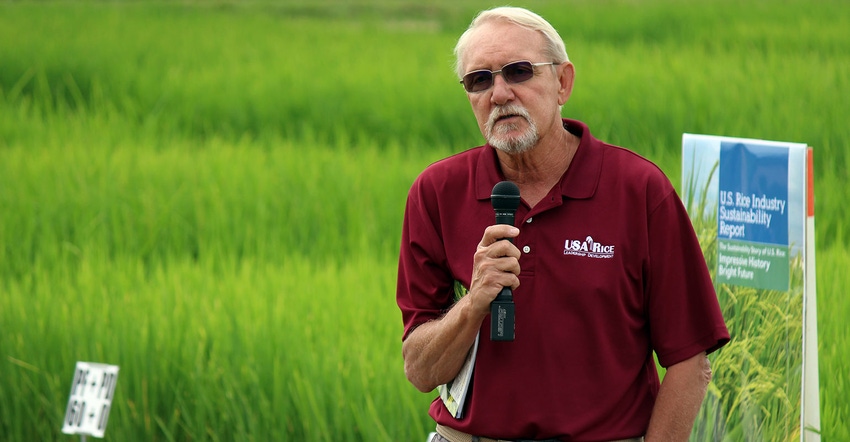
In 2017, Dr. Steve Linscombe retired from the Louisiana State University Rice Research Center after 35 years of service, but he has much more he wants to do for the industry that fueled his career for so long.
Linscombe, a world renowned and respected rice breeder and researcher with over 30 varietal releases to his credit, knows that when one door closes, another one usually opens, and for him, that door led to an opportunity to become the new executive director of The Rice Foundation.
He returned to Crowley, La., last month to participate in the 110th Annual Rice Field Day with a specific message to each rice farmer in attendance. “The rice industry has come so far in terms of environmental, social, and economic improvements,” says Linscombe. “These three areas are being called our pillars of sustainability, and they are interwoven. You can’t have one without the other. We have a great message that must be told to the end users of our product, and we have recently taken a big first step to tell it.”
Thanks to a grant from the Natural Resources Conservation Service (NRCS), The Rice Foundation was able to commission a rice industry sustainability report that highlights 36 years of constant improvements and how those improvements have solidified the U.S. rice industry’s position as one of, if not the most, sustainable in the world.
While the definition of sustainability may be open to interpretations, the U.S. rice industry’s extensive track record of improvements is evident, and Linscombe complimented the many growers who have helped make those improvements.
“U.S. rice farmers have not only raised the yield bar tremendously, they have increased rice production’s land use efficiency by 34 percent over that time period,” says Linscombe. “Through a 52 percent reduction in water use, less trips across fields through adoptions of conservation tillage, and more efficient equipment, 34 percent less energy is being used to produce our nation’s annual rice crop — that’s huge.”
Climate change and biodiversity
Linscombe noted that no matter your view about climate change, it is real, and the 1,000-pound gorilla in rice production is the large volume of methane being emitted from each year’s crop. “Upland crops don’t produce high volumes of methane because they’re not flooded,” he told the tour group. “When you get into an aquatic situation, there’s more tendency to produce methane, but the gains made by all of you and other growers across the six rice-producing states have helped this industry as a whole reduce our cumulative methane production by over 40 percent.”
Soil loss has never been an issue or major concern in rice production, but that does not mean it was overlooked in this sustainability analysis. “Because of the way rice has been produced through the decades, we have actually decreased soil loss by 28 percent,” says Linscombe. “We do have an area where our industry can really take great pride, and that is in the area of biodiversity.”
Production rice ground contributes to the biodiversity of habitats for a wide variety of birds, waterfowl, and other animals that make rice fields their homes or stopping grounds along their migratory routes. Grain and crop stubble left after harvest are actively foraged by this flurry of activity.
“Rice farmers have provided very diverse waterfowl habitats for many decades, but six years ago, an alliance solidified between USA Rice and Ducks Unlimited through the creation of the Rice Stewardship Partnership (RSP) significantly propelled these conservation efforts forward,” says Linscombe. “NRCS matching grant funding, through its Regional Conservation Partnership Program, as well as funds from private partners, is helping rice farmers implement conservation practices on their operations.”
In the report, value placed on the habitats created by overwintered flooded rice fields is estimated to be almost $3.5 billion. “The partnerships between these aforementioned organizations and these funds they bring to the table will be used by rice producers to create and sustain essential habitat areas on over 700,000 acres of production rice fields between now and 2023,” says Linscombe.
Economics and the future
Findings in the report state rice farming operations, rice mills, and the 125,000 jobs they create contribute over $34 billion annually to the U.S. economy. “Our ag economists found that each rice farm contributes $1 million to its local economy,” says Linscombe. “That doesn’t even count impact from the number of sponsored activities and civic donations rice industry organizations make to communities and food banks.”
While each aspect of any sustainability analysis is important and contributes to an industry’s overall sustainability picture, any industry would collapse if it lacked one particular aspect — economic sustainability. “If rice farmers and rice mills are not profitable, it will have negative ramifications down the supply chain,” says Linscombe. “In many cases, a town or a community’s economic stability relies almost exclusively on the business of rice.”
As more rice operations adopt new technologies like variable rate equipment and automated water control structures, the sustainability levels reflected in those three pillars should improve. Mills are also making sustainability improvements by moving toward no-waste practices and using renewable energy sources.
The U.S. Rice Industry Sustainability Report is the first of its kind for the industry. An executive summary of the report and the full version in pdf format are available electronically at https://www.usarice.com/sustainability/sustainability-report.
You may also contact The Rice Foundation at 1-800-888-RICE (7423) for a printed copy.
About the Author(s)
You May Also Like




